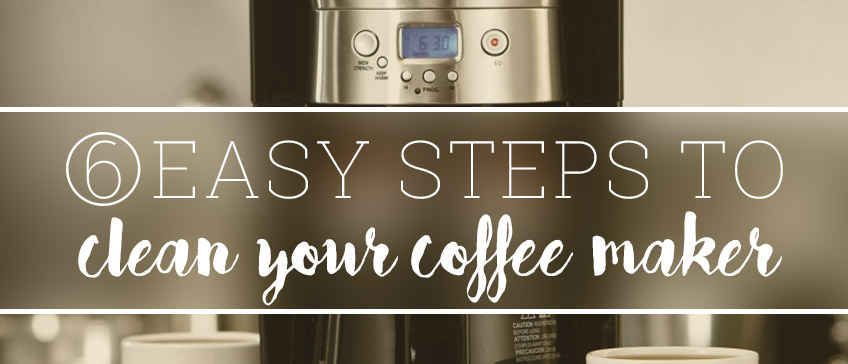
Americans drink an average of three cups of coffee per day, making it a vital part of our daily routine. When making that perfect cup of coffee at home, you always use the tastiest coffee beans, the purest filtered water, and your very favorite coffee mug… but are you really doing everything you can to ensure the best tasting cup of coffee possible?
It might surprise you to learn that a 2011 NSF study found the kitchen to be the germiest place in the home, with more germs hiding in coffee maker reservoirs than on bathroom faucet handles, light switches, and even pet toys! Not only can improperly cleaned coffee makers harbor yeast and mold that might make you sick, but oily residues, hard-water deposits, and other impurities can build up over time to spoil your best efforts at a delicious cup o' joe.
By adding just a few simple steps to your coffee making routine, you can ensure that your daily cup of coffee gives you that extra pep in your step without any harmful germs or unpleasant tastes.

- After you've finished with your coffee, dump any remaining liquid out and clean the carafe with liquid coffee pot cleaner or soap and water. Not only can stuck-on coffee stain your carafe, but it can also leave behind residues that may affect the taste of your next brew.
- Remove your coffee maker's filter. If your coffee maker uses a permanent filter, dump out the grinds and wash it. If you coffee maker uses disposable filters, simply remove the filter and throw it away.
- You should remove the filter holder on a regular basis and rinse it off, as coffee grinds have a tendency to settle there.
- Wipe your coffee maker down with a wet rag. Pay special attention to the hot plate when it has cooled, as this area tends to accumulate coffee drips that can build up over time and lead to an unpleasant burning coffee smell.
- Depending on how hard your water is, your coffee maker should be decalcified every 1-3 months using a decalcifying agent or white vinegar and water in order to remove any mineral build-up.
- When using a white vinegar and water solution, fill the coffee maker's water chamber with equal parts white vinegar and water, then start a brew cycle. Turn off the coffee maker midway through the cycle and let it sit for an hour. After an hour, resume the brew cycle. Pour out the vinegar and water solution and then run a new brew cycle using only water. Repeat this water-only cycle two more times to fully rinse out your coffee maker, giving your coffee maker time to cool slightly in between brews.


 Single Faucet Kegerator Beer Dispensers
Single Faucet Kegerator Beer Dispensers Dual Faucet Two Tap Kegerators
Dual Faucet Two Tap Kegerators Triple Faucet Three Tap Kegerators
Triple Faucet Three Tap Kegerators Undercounter Built-In Kegerators
Undercounter Built-In Kegerators Outdoor Kegerator Beer Dispensers
Outdoor Kegerator Beer Dispensers Commercial Kegerators
Commercial Kegerators Mini Kegerators
Mini Kegerators Cold Brew & Nitro Coffee Dispenser Kegerators
Cold Brew & Nitro Coffee Dispenser Kegerators Carbonated Water Kegerators
Carbonated Water Kegerators Home Brew Kegerators
Home Brew Kegerators 15" Kegerators
15" Kegerators Kombucha Equipment
Kombucha Equipment Guinness® Dispensing Kegerators
Guinness® Dispensing Kegerators Vending Kegerators
Vending Kegerators Wine Kegerators
Wine Kegerators Kegerator Cabinets
Kegerator Cabinets Kegerator Covers and Accessories
Kegerator Covers and Accessories Kegerators
Kegerators Kegerator Conversion Kits
Kegerator Conversion Kits Kegs & Keg Accessories
Kegs & Keg Accessories Beer Faucets
Beer Faucets Beer Shanks
Beer Shanks Draft Beer Towers
Draft Beer Towers Keg Taps Couplers
Keg Taps Couplers Regulators & Gas Equipment
Regulators & Gas Equipment Beer & Gas Line Hose
Beer & Gas Line Hose Co2 and Nitrogen Air Tanks
Co2 and Nitrogen Air Tanks Beer Line Cleaning Equipment
Beer Line Cleaning Equipment Drip Trays
Drip Trays System Fittings
System Fittings Jockey Boxes
Jockey Boxes Keg Beer Party Pumps
Keg Beer Party Pumps Glassware & Accessories
Glassware & Accessories Guinness® Dispensing Equipment
Guinness® Dispensing Equipment Remote Glycol Systems
Remote Glycol Systems Wine Cooler Refrigerators
Wine Cooler Refrigerators Wine Cellar Cabinets
Wine Cellar Cabinets Wine Racks
Wine Racks Cooling Units
Cooling Units Wine Dispensing Systems
Wine Dispensing Systems Wine Glasses
Wine Glasses Wine Accessories
Wine Accessories Howard Miller Wine & Spirits Furniture
Howard Miller Wine & Spirits Furniture Wine Making
Wine Making Nitro Hot Draft System
Nitro Hot Draft System Ready to Drink Bag-in-a-Box Coffee Dispenser
Ready to Drink Bag-in-a-Box Coffee Dispenser Nitrogen Infusers
Nitrogen Infusers Nitrogen Beer Regulators
Nitrogen Beer Regulators Nitrogen Tanks & Generators
Nitrogen Tanks & Generators Nitro Cold Brew Coffee Kegs
Nitro Cold Brew Coffee Kegs Cold Brewed Coffee Tools
Cold Brewed Coffee Tools Espresso Machines
Espresso Machines Cleaning Equipment
Cleaning Equipment Outdoor Appliances
Outdoor Appliances ADA Appliances
ADA Appliances Panel Ready Appliances
Panel Ready Appliances Commercial Grade Appliances
Commercial Grade Appliances Beverage Centers
Beverage Centers Refrigerators
Refrigerators Ice Makers
Ice Makers Water Dispensers & Accessories
Water Dispensers & Accessories Freezers
Freezers Blenders & Juicers
Blenders & Juicers Home Brew Equipment Kits
Home Brew Equipment Kits Fermentation Equipment
Fermentation Equipment Boiling and Mashing Equipment
Boiling and Mashing Equipment Home Brew Beer Kegs
Home Brew Beer Kegs Home Brew Kegerator Conversion Kits
Home Brew Kegerator Conversion Kits Brewing Tools
Brewing Tools Home Brew Ingredients
Home Brew Ingredients Cleaning Chemicals
Cleaning Chemicals Test Equipment
Test Equipment Home Brew Beer Bottles and Bottling Equipment
Home Brew Beer Bottles and Bottling Equipment Brewery Fittings
Brewery Fittings Draft Beer Equipment
Draft Beer Equipment Homebrewing Equipment
Homebrewing Equipment Wine Equipment
Wine Equipment Luxury Appliances and Refrigeration
Luxury Appliances and Refrigeration Coffee Equipment
Coffee Equipment Home Bar & Barware
Home Bar & Barware Kombucha
Kombucha The Beverage Blog
The Beverage Blog Frequently Asked Beer Questions
Frequently Asked Beer Questions Shop by Brand
Shop by Brand Shop by Category
Shop by Category